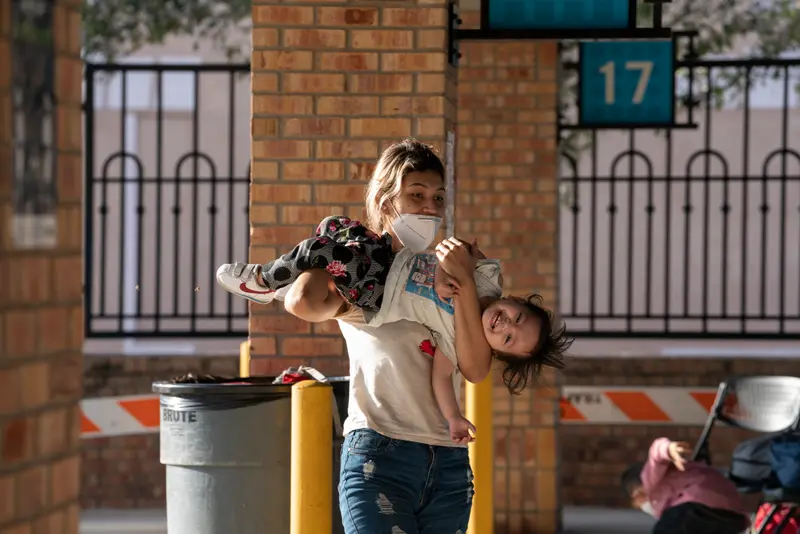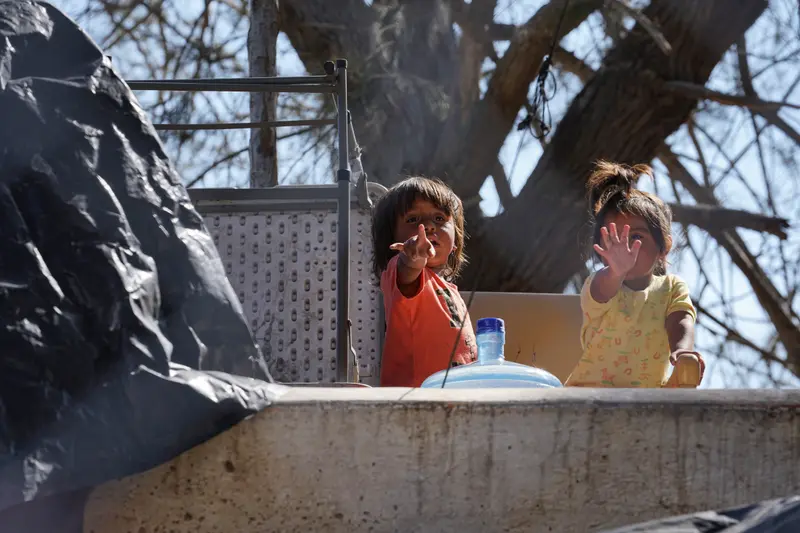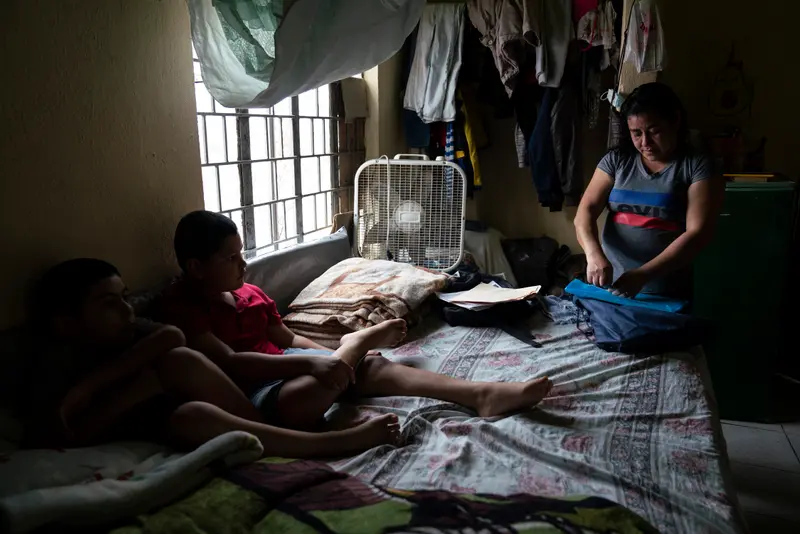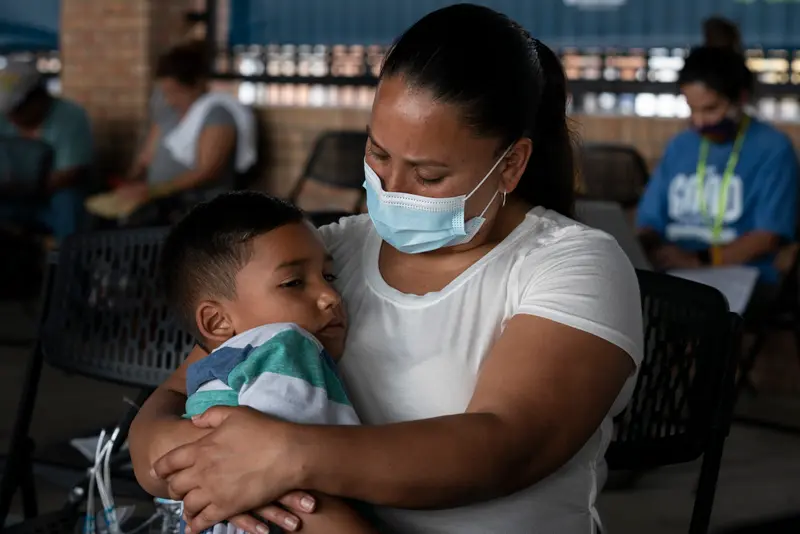No matter how hard he tried, Jonatan Garcia said, he couldn’t find steady work in Guatemala. He dabbled in construction, and on some days picked beans, after losing his sales job at a TV station a few weeks after the pandemic shuttered businesses and further stifled employment in his country.
Desperation quickly mounted for Garcia. He struggled to make enough money to provide food for his wife and two small children, and they faced eviction from the three-room house they rented in the mostly indigenous and impoverished rural state of Baja Verapaz.
Then, Garcia said, smugglers falsely told him that President Joe Biden had signaled during a television appearance that migrants would be allowed to enter the United States. The new administration has been trying to combat such misinformation as it seeks to rein in the influx of migrants at the southern border of the U.S.
Garcia borrowed nearly $7,000 from a friend and, aided by a smuggler, traveled to Texas with his 6-year-old son. He left behind his wife and baby while he searched for stable employment.
Garcia and his son were among a record-setting number of migrants who were detained while attempting to enter the country at the U.S.-Mexico border in March and April under confounding policies that have turned the immigration process into a game of roulette. While not rising as rapidly as they had in the months immediately previous, border detentions reached a 21-year high after increasing again in April, according to federal statistics released this week.
Because of a lack of uniform policies and uneven enforcement of some laws in the U.S. and Mexico, migrants can be granted or denied entrance into the country based on a variety of factors, including where they cross and the age of their children. Smugglers have exploited the confusion to manipulate vulnerable migrants into making the journey north, adding to the sustained influx at the border, experts said.
Migrants were taken into custody by U.S. Customs and Border Protection a total of 178,622 times in April. The data includes migrants who have previously crossed. Nearly 67,000 individuals, mostly those crossing with their families and unaccompanied children, were allowed to stay in the U.S. while they seek protection from deportation. The remainder, largely single adults, were summarily turned away under a health order instituted by former President Donald Trump and continued under Biden that denies entrance to the country during the coronavirus pandemic.
In his first presidential address to Congress last month, Biden said the U.S. must contend with the root causes of migration that force people to flee their countries, including persistent violence, poor economic conditions aggravated by the pandemic and two hurricanes that pummeled Central America last year.
But the deteriorating circumstances in that region, combined with disparate U.S. immigration policies, have created a chaotic situation at the border that is worsened by the perception of mixed messaging from the Biden administration, said Andrew Selee, president of the Migration Policy Institute, a Washington, D.C., think tank.
“Messages matter, perceptions matter, but the sudden spike on the ground is because people hear others are getting in,” Selee said. He added, “Many people wait until they see there is some proof that you can actually cross the border, even if it is tentative.”
The Biden administration has ramped up Spanish-language media campaigns in Central America that urge migrants to stay in their home countries as it seeks to repair what officials have called a fractured U.S. asylum system.
But such public messages are muddled by Biden reversing some of Trump’s immigration policies while maintaining others, according to experts who said that at times they too struggle to make sense of who gets into the country and who doesn’t. Below is a breakdown of how some of those policies and decisions have played out for Garcia and hundreds of thousands of migrants arriving at the border.
Some Families With Children Under 7 Are Allowed to Enter
On the day that Garcia waded through the Rio Grande at the southernmost tip of the U.S.-Mexico border, the vast majority of the 200 families in his group were immediately sent back.
But Garcia and his son were allowed to stay.
“I guess we were lucky,” said Garcia, who now lives near his mother-in-law in New Jersey while he awaits a July court date to plead his asylum case.
During the journey, Garcia said, he learned that many families were turned away, while those with children his son’s age and younger were allowed to enter the U.S. to await court hearings.
Under the Trump administration, the U.S. began sending migrants seeking asylum to Mexico until their cases could be heard. The process requires cooperation from the Mexican government, which has been overwhelmed by the number of migrants in its border cities.
Officials in the Mexican state of Tamaulipas, where Garcia crossed, have increasingly denied U.S. attempts to return families with young children to the state. They cite a lack of capacity in shelters, according to the Biden administration. Such rejections appear to be the result of a new Mexican law, implemented in January, that prevents the detention of migrant children and mandates that they instead be housed by the country’s family welfare agency.
“With the Rio Grande Valley, there are some families who cannot be expelled in that particular area of the southwest border by reason of capacity constraints in Mexico,” U.S. Homeland Security Secretary Alejandro Mayorkas told reporters last week.
As Tamaulipas rebuffs U.S. efforts to return certain families with young children, other Mexican states continue to accept them. It is unclear why the Mexican law appears to be enforced mostly in Tamaulipas, five experts told ProPublica and The Texas Tribune.
In some cases, the U.S. government has bused or flown migrant families entering through Tamaulipas to different areas along the border, including El Paso and San Diego, and then sent them to Mexican states adjacent to those locations. Mayorkas said last week that the administration was taking a “close look” at whether to continue expelling families not accepted by Tamaulipas. On Thursday, the government told CBS News that it would no longer fly families elsewhere, but would still bus them to other areas for expulsion.
One potential explanation for the uneven implementation of the law is that the Tamaulipas welfare agency is underfunded, and more migrant families cross there than in other border states, said Ariel Ruiz Soto, an analyst at the Migration Policy Institute.
“The bottom line is that this is all relatively murky,” Ruiz Soto said. “It is a mixed result of shelter capacity and increasing discretion by Mexican authorities, not only one or the other.”
He added that welfare agencies in Tamaulipas “are simply not equipped” to handle the current migrant family flow. That sentiment was reinforced by Jean Gough, regional director for Latin America and the Caribbean at the United Nations’ refugee agency for children.
Gough said in an April statement that most of the shelters she visited across Mexico were overcrowded and could not accommodate the surging number of families and children arriving at the border. Children represent more than 30% of migrants in Mexican shelters. Half of them traveled without their parents, one of the highest percentages of unaccompanied minors ever recorded in Mexico, Gough said.
The agency estimates about 150,000 children and families affected by violence and poverty in their places of origin will require humanitarian assistance in Mexico during the next two years.
The Mexican government did not respond to specific questions from ProPublica and The Texas Tribune.
Biden Is Accepting 25,000 Migrants With Pending Cases
One of Trump’s signature border initiatives was the Migrant Protection Protocols, which forced people seeking asylum to wait in Mexico until their cases could be heard by U.S. immigration judges.
The policy, also known as “Remain in Mexico,” was a departure from the traditional asylum process, which generally allowed those requesting protection to stay in the U.S. until their claims were adjudicated.
Between 2019 and January of this year, the Trump administration ordered more than 71,000 migrants to stay in Mexican border cities pending their court hearings. A majority of the migrants were later denied protection from deportation.
In February, Biden issued an executive order that suspended the policy and began the process of allowing into the U.S. about 25,000 migrants whose cases had not yet been decided. More than 10,200 have since entered the country, according to the U.N., which is processing asylum seekers in six Mexican border cities.

Biden’s decision paused a case before the U.S. Supreme Court and several other lawsuits challenging the policy, drawing early praise from advocates who are seeking resolution outside of the courts.
In April, Texas Attorney General Ken Paxton and Missouri Attorney General Eric Schmitt sued the administration to reinstate the policy.
The Republican officials argued in court filings that MPP was an effective tool for turning back migrants at the southern border. Halting the policy, they said, imposed “severe and ongoing burdens” on the two states, including forcing them to provide health care and education for migrants. A Department of Justice spokesperson declined to comment on the case.
Unaccompanied Migrant Children Are No Longer Expelled
In one of his most consequential immigration actions as president, Biden stopped a Trump practice of expelling children who had crossed the border alone.
Unaccompanied minors generally have broad protections under long-established U.S. law because they have widely been viewed by both Republicans and Democrats as more vulnerable.
But in a stark reversal of such policies, the Trump administration in March 2020 instituted the pandemic health order known as Title 42. The order used an obscure provision of the federal public health and welfare code to justify making more than 733,830 expulsions of adults and children at the border without asylum screenings.
Among those sent back last year were a 17-year-old girl who had been raped and her baby. The teenager asked U.S. agents for asylum, saying her abuser had threatened to make her “disappear” in Guatemala. Federal agents expelled the girl and her infant, forcing a scramble by international refugee organizations to relocate them to a third country because of concerns for their safety.
A federal district judge in Washington ruled in November that the government could not expel unaccompanied minors, after advocacy organizations sued. The decision was reversed by a federal appeals court in January, but Biden said his administration would not continue the practice.
“The idea that I’m going to say, which I would never do, if an unaccompanied child ends up at the border, we’re just going to let them starve to death and stay on the other side — no previous administration did that either, except Trump,” Biden said at his first presidential press conference in March. “I’m not going to do it.”

The number of unaccompanied children crossing the southern border of the U.S., which had been slowly rising since April 2020, skyrocketed after Biden’s announcement.
About 18,900 children entered alone in March, surpassing the previous monthly record of nearly 11,500 detained at the southern U.S. border in May 2019. In April, the number of unaccompanied minors declined by 9% to just under 17,200.
A growing number of children are being sent alone across the U.S. border by desperate parents who made the decision to separate from their kids after being forced to wait in Mexico under Trump and Biden policies, immigration lawyers and advocates said.
Paxton, the Texas attorney general, cited the high number of unaccompanied minors in his fourth lawsuit challenging the Biden administration’s border policies. DOJ officials declined to comment on the lawsuit, which aims to force Biden to resume the practice of expelling unaccompanied migrant children.
Most Single Adults Are Turned Away Under the Pandemic Health Order
Despite halting the expulsion of children under Trump’s health order, Biden has maintained the policy for most single adults and some families, effectively shutting them out of the asylum process.
Previously, migrants who asked for protection had a chance to make their claims to U.S. authorities. If they passed an initial screening, they would argue their cases before immigration judges in formal proceedings that could take months and would often lead to deportation. Those who returned to the U.S. after being removed could face prison for reentering illegally.
Under the health order, Border Patrol agents expel migrants in proceedings that take an average of 90 minutes and include no asylum screenings, court hearings or criminal prosecutions.
In April, federal officers returned nearly 110,000 migrants under the health order, 3% more than in March. Most were single adults, and nearly a third had been previously expelled, CBP officials said.
In danger in Mexico and facing no criminal consequences for making multiple crossing attempts, many migrants have repeatedly tried to enter since the health order went into effect. Since Biden took office, advocacy groups, including Human Rights First, tracked almost 500 attacks by criminal groups, Mexicans, and other migrants against people who had been expelled from the U.S..
Aaron Reichlin-Melnick, policy counsel at the American Immigration Council, an advocacy group, criticized Biden’s continued use of the directive, calling it harsher than MPP. The latter, he said, was “at least a fig leaf of due process,” whereas the health order “provides nothing but a one-way ticket back to Mexico.”
Under the current policy, few exceptions exist. But starting this month, the U.S. is allowing more migrants to enter the country for humanitarian reasons, in a process that includes coordination with advocacy groups. The White House and the Department of Homeland Security declined to say how many migrants have been allowed in under that status by the Biden administration.
In May, Eledin Garcia, a 26-year-old from Honduras, was permitted into the U.S. from Mexico after previously being turned away under the pandemic health order. With the help of an attorney, Garcia successfully persuaded the government that he should be granted a humanitarian exception because he is gay and other migrants with the same sexual preference have been assaulted in Matamoros, Mexico, across the border from Texas in the Rio Grande Valley.
“It is impossible to explain how overjoyed I am,” Garcia said shortly before boarding a flight to Florida, where he has relatives.
Thousands Are Still Waiting to Enter, Hoping for Asylum
Thousands of migrants whose asylum claims were denied under the Trump administration have been waiting in Mexico and other countries for an opportunity to try again under Biden.
In typical asylum proceedings, migrants with rejected cases would be deported to their home countries. They would then face a higher legal standard if they sought protection a second time.
But attorneys and migrants said the Biden administration should recognize that many asylum cases were dismissed through an MPP process that was plagued with problems, including hearings in tent courts where migrants often lacked attorneys and proper translation.
Most migrants with denied MPP cases did not appear in court for their final hearings, according to federal statistics. Ariana Sawyer, a researcher with Human Rights Watch, said some were kidnapped, while authorities bused hundreds more to cities in the interior of Mexico, making it harder for them to attend proceedings in the U.S. More than 1,500 migrants waiting in Mexico under MPP were killed or assaulted, according to Human Rights First and other advocates.
The majority of migrants in the MPP program lacked legal representation. Only about 8% had attorneys, according to federal data analyzed by Syracuse University.
Biden has not said whether migrants with denied asylum cases will get another shot. But, in March, his administration allowed some migrants whose MPP cases had been dismissed into the U.S. after it shuttered a tent camp in Matamoros, Mexico, that had become notorious for poor conditions. DHS officials said admissions from that camp were based on “urgent humanitarian concerns” and that they also sought to keep families together.

Marbin Arnuby is one of thousands of migrants denied asylum under MPP who are waiting for additional opportunities to make their cases under Biden.
Arnuby, who asked that his middle name be used instead of his last name out of fear of retribution, said he fled Honduras after gang members, furious that he refused to sell drugs, killed his brother in June 2019. Arnuby carries a picture of his brother’s tombstone and his death certificate, which lists strangulation as the cause.
The 32-year-old attempted to cross the border in October 2019 but was returned to Mexico. At a hearing in 2020, a U.S. immigration judge denied his asylum claim.
Arnuby, who did not have a lawyer and does not speak English, said the judge told him he had not provided enough proof that he faced danger in Honduras. He tried to appeal the ruling, but said he missed the deadline because immigration courts were closed on account of the pandemic and access to ports of entry was restricted.
After losing his immigration case, Arnuby could not renew his work authorization in Mexico. He remained in Matamoros until March, renting a room after leaving the tent camp where he’d lived for seven months.
Arnuby said he fled the settlement last year after he was assaulted, a move that inadvertently made him miss a chance to enter the U.S. when Biden dismantled the camp in March.
That month, Arnuby sought a COVID-19 test at a Mexican government facility. There he was detained and deported to Honduras, where, he said, he is now in hiding because he fears gang members.
Arnuby plans to return to the U.S. border to try again.
“I have no hope here,” he said.
Other migrants under different circumstances are also still waiting.
Beginning in 2018, the Trump administration sharply limited the number of migrants who could seek asylum at U.S. ports of entry, a manner of requesting protection that is codified within U.S. and international law.
Under a practice known as metering, U.S. officials began allowing only a handful of migrants a day to ask for asylum. To keep their place in line, migrants created informal waiting lists, which were run by asylum seekers, shelters and Mexican authorities. The migrants could have crossed illegally and asked for asylum once detained by Border Patrol agents, as hundreds of thousands have done. But some migrants prefer to request protection at ports of entry, in part because it is safer. While it is lawful to ask for asylum anywhere along the border, criminal organizations often charge migrants to cross illegally at points other than designated ports of entry.
Ports of entry have been closed to asylum seekers during the pandemic, so more than 16,000 migrants remain on those waiting lists, said Savitri Arvey, a researcher on migration at the University of Texas at Austin. Some migrants, including a large number of Haitian and African asylum seekers, according to advocates, have been waiting as long as two years to ask for asylum at U.S. ports of entry.
“There is growing anguish,” Arvey said. “The messaging is just really unclear, and there is a lot of confusion on the path forward for people who have been waiting for so long.”
A Need to Fix Legal Pathways and Overburdened Courts

Biden has proposed immigration bills that would provide a pathway to citizenship for about 11 million immigrants already in the U.S., fund border security technology and expand legal immigration.
All require approval from Congress. Republican senators have threatened to filibuster the legislation, saying the administration must first contend with the latest influx at the border.
But experts said the country’s challenges at the southern border are driven by the inability of Congress to significantly reform the immigration system over the past three decades. Selee, from the Migration Policy Institute, said that U.S. officials should have learned by now that enforcement only works if there is a way to channel at least some people onto legal pathways.
“If you create a line that you can actually get into, over time it changes people’s options,” Selee said. “The sense for many people in Central America is that when there’s an opening, you grab it.”
Biden announced earlier this month that he would raise the cap for admitting refugees to 62,500 but said the number would not be reached this fiscal year. Only about 5,000 slots would be available to people from Central and South America, who are driving the largest number of detentions at the border. Refugees differ from asylum seekers in that only a limited number can receive that status. They are also screened outside the U.S. through the U.N., while asylum seekers request protection at the border.
Experts said few avenues exist for Central Americans seeking protections that include asylum. They pointed to a lack of predictability about when and how migrants qualify for protection and the need for additional pathways for temporary work. Expanding provisional employment programs for people from the region would reduce the strain of asylum seekers at the border, said Alex Nowrasteh, director of immigration studies at the Cato Institute, a libertarian think tank.
In the absence of significant reforms, experts said, an overburdened immigration court system has become the arbiter for many trying to come to the U.S. Overseen by the DOJ, the court system has a record backlog of more than 1.3 million cases. On average, a case can take more than two years to decide.
The Trump administration added more than 330 immigration judges. Biden has asked Congress to fund 100 additional judges to bring the total to 634, said Kathryn Mattingly, a spokesperson for the DOJ’s Executive Office for Immigration Review.
Theresa Cardinal Brown, a former DHS official who is managing director of immigration and cross-border policy at the Bipartisan Policy Center, a Washington think tank, said the Biden administration should order asylum officers to directly decide the protection claims of migrants at the border, rather than having them wait years for their cases to be determined in court.
“Immigration courts should be the last resort, not the first resort, when it comes to adjudicating asylum,” Cardinal Brown said. “This avenue has become the only avenue for people to try and has completely overwhelmed the systems put in place to deal with a much smaller number of people, which is why we need to rethink all of that.”











